Ranger Kristin noticed a white silky substance covering part of the clover leaves at our feet. Bending down to get a closer look we realized that there was something moving under that white substance. It looked to be some sort of larvae, very small larvae.
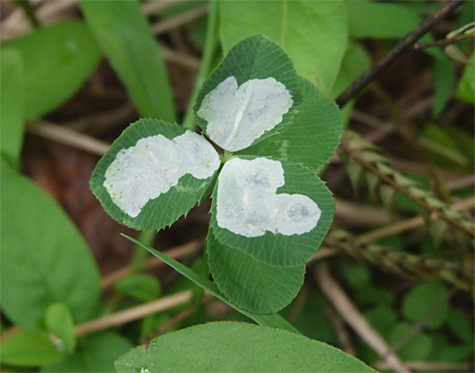
The plant was White Clover (Trifolium repens). The leaves of the plant themselves are small, each leaflet about 15 mm, and in comparison the larvae were elfin. They looked to be about 1 – 2 mm in length.
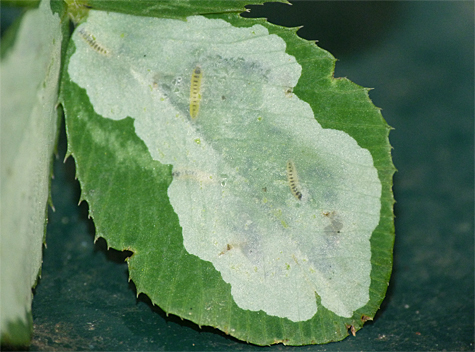
Kristin and I happened to be walking along the path on the north side of the Wetlands. The Museum hadn’t opened yet and there were no guests to engage so we decided to walk around the outdoor loop to look for, well, whatever kind of bug, bird, or herp happened to be about on that fine Saturday morn.
Kristin peeled back the white coating on one of the leaves. Underneath, there were three tiny larvae. I immediately thought, butterfly or moth. There are several species of butterfly that use clover as a host plant, and there are about 10.5 thousand species of moth in North America, there certainly must be one that uses clover as a host.
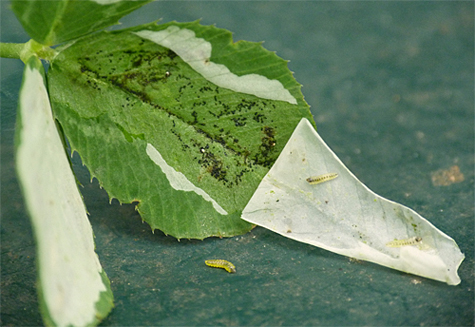
A close look at the larvae had me scratching my head, I couldn’t see any legs on the little creatures. They looked more like beetle or fly larvae than caterpillars. They looked like grubs.
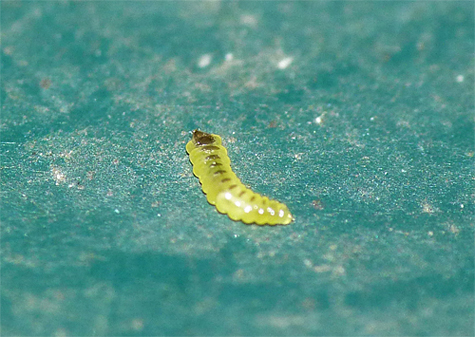
Caterpillars have legs, six real legs and up to ten prolegs. Sawfly larvae have even more prolegs than butterflies or moths. I couldn’t see legs of any kind on these Lilliputian larvae. Lepidoteran? I doubt it.
I was going to need help to solve this mystery. I uploaded photos of the day’s events to BugGuide.Net “…an online community of naturalists who enjoy learning about and sharing our observations of insects, spiders, and other related creatures.” I’ve had much luck in the past using BugGuide.Net while trying to identifying insects that were unfamiliar to me. The folks who monitor and follow BugGuide are passionate about their interest, very helpful, and most importantly, patient.
Almost immediately there was some speculation as to whether the larvae were beetles or moths. There was, though, a consensus that they were some kind of leaf miner.
Leaf miners are insects whose larvae eat leaf tissue in layers, leaving behind a trail through the leaf. It’s often a squiggly line across and around the leaf, but sometimes they leave neat rows back and forth across the leaf. The leaf more or less stays intact with just a thin layer of the leaf missing.
Typical caterpillars eat along the outside edge of the leaf removing sections of the leaf at each sweep. When they’re done eating there is often no leaf left. Leaves that are not completely consumed have the appearance of having been eaten, they have visible bite marks.
It was suggested by someone on BugGuide that I rear the larvae to see what emerges. I picked a few of the clover leaves, placed them in plastic vials, a small vial to contain the leaves with water, another larger vial to contain the smaller one and to give whatever emerges room to move about.
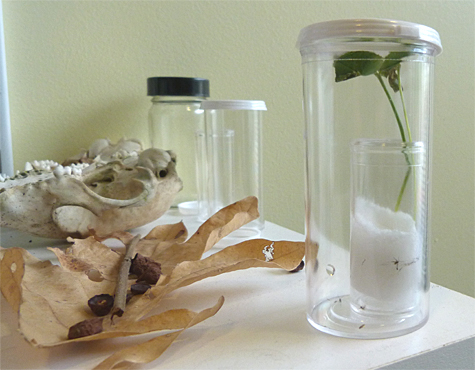
The larvae were first noticed on 8 September. The clover was picked and placed in vials on 11 September. On September 19, I noticed a tiny elongated speck on the inside of the large vial, and another on the stem of the clover. I couldn’t quite tell what they were but they look liked a fly of some sort. All together, I counted three of them.
I got out the close-up attachment for the camera. I took a chance and emptied one of the tiny insects onto my desktop. It didn’t fly away! Through the close-up lens I could see it was a moth. I was able to get several acceptable photos.
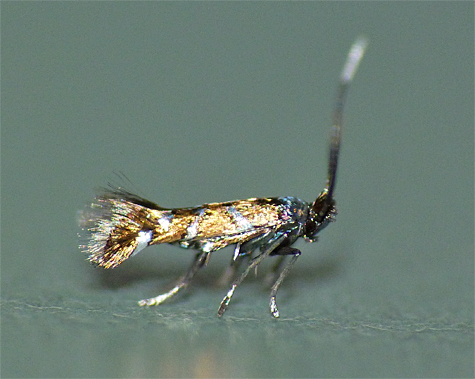
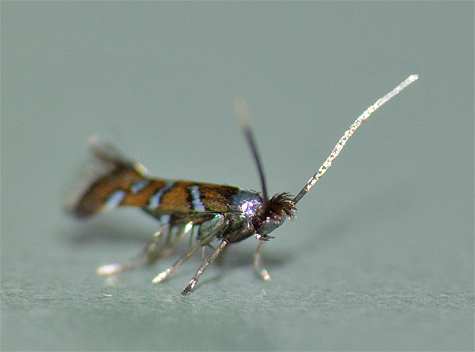
This little creature measured about 2 mm in length (it sat still while I measured it). Get out your ruler, there’s probably one on your desk, or in one of the drawers. Your ruler has inches on one side and millimeters on the other. Look at the millimeter markings on the ruler. Two millimeters is small. That’s 0.078740157 inches. Mosquitoes are larger!
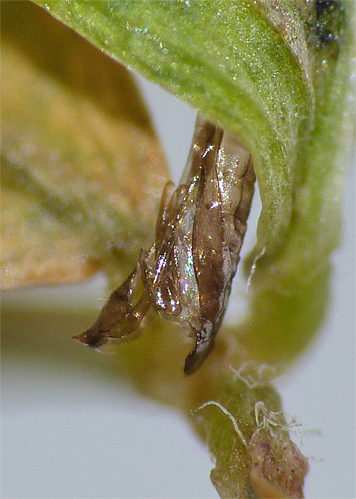
Okay, so it was a moth, but what kind of moth. Back to BugGuide.Net with an upload of the photos of the adults. It didn’t take long for someone to recognize the adult. In fact there were already photos of the adults on BugGuide as well as other sites around the Internet.
Here’s two sites:
http://www.microleps.org/Guide/Gracillariidae/Lithocolletinae/Porphyrosela/index.html
Check the URL of the site above, www.microleps.org. This web page is “…a site dedicated to the study of eastern-Nearctic microlepidoptera…” in other words, small moths and butterflies of eastern North America.
http://mothphotographersgroup.msstate.edu/species.php?hodges=843
If you’ve clicked on the two links above you now know that the moth appears to be a Porphyrosela desmodiella, a member of a family of moths called Leaf Blotch Miner Moths (Gracillariidae). My moths do indeed look like Porphyrosela desmodiella (apparently, Porphyrosela desmodiella doesn’t as yet have a common name).
These moths are tentiform leaf miners, meaning that they construct a covering over their work area, a tent-like structure, apparently to conceal themselves from things that would eat them. The problem is, that according to the information that I’ve read about Porphyrosela desmodiella it supposedly makes its tents on the underside of the leaves of plants in the family Fabaceae.
The moth in my case had tents formed on the leaves of Trifolium repens, which is indeed a part of the Fabaceae family, but its tents were on the upper surface of the leaves, not the underside.
After a bit more searching, I found a web page which has a photo of Trifolium repens with the same tents that Kristin spotted in Explore the Wild, only this clover was in Uruguay, and the moth larvae that constructed it was Porphyrosela minuta not Porphyrosela desmodiella. Unfortunately there was not a photo of the adult moth on the page or anywhere else that I searched.
There’s another problem. Porphyrosela desmodiella is supposed to pupate within a curled up leaf. While I did find a spent pupal case, or exuvia, inside one of the clover leaves (above photo), three of them were attached to one or the other vial (If you’re counting you may have noticed that there were four pupa and only three adults. I didn’t find the fourth pupal case till much later when prompted to after reading about how and where Porphyrosela desmodiella is supposed to pupate. I apparently did not see one of the adults when they all emerged).
So, what’s going on here? Well, either the facts about the tents of the tiny moth here in Durham (Porphyrosela desmodiella) are not fully known or the moths that I reared are not Porphyrosela desmodiella.
I’m currently attempting to rear more of these micro moths in order to send them to Don Davis, Curator of Lepidotera at the Smithsonian in DC. The moths that I reared previously, and that you see in the photos above, have all flown away. I initially left the lid to the vials partially open and they all flew the coop. While I did pick a new batch of clover leaves, it’s not a certainty that moths are going to result from my effort. We’ll have to wait and see.
In the event of a failure, I do have a back-up. When the initial batch of moths emerged from the pupal stage they were perched at various places within the vial, one on a clover leaf, the others on the inside surface of the large vial. While moving the vial to get a look at the moths the smaller vial rolled around and unintentionally smeared one of the tiny moths across the inside of the larger vial. I’ve been told that my smeared moth may be all I need in order to positively identify the moths, as long as the genitalia are in good shape.
So, until I either have more moths emerge in the vials or I send in the squashed moth for positive identification, we’ll just have to call these micro moths, Porphyrosela sp.
By the way, Porphyrosela desmodiella is not restricted to the US, it’s also found in Brazil, Canada, Cuba, and the Virgin Islands, and probably many more locations. And, the plant that the moth larvae was found on, White Clover or Trifolium repens, originated in Europe, North Africa, and West Asia but is now found throughout the Western Hemisphere.
Agromyza nana?
Did you ever find out more and positively identify? I found the same type of shots on white cover in my yard and was curious. Thanks!
The moth has been indentified on Bug Guide as Porphyrosela minuta Here’s the link (https://bugguide.net/node/view/1022610). And here’s a quote from Bug Guide “The only known native Porphyrosela in the US, P. desmodiella, is very similar as an adult. However, it makes underside tentiform mines, not flat upperside mines like those of P. minuta, and Trifolium is not one of its known hosts..”
I assume that their identification is correct.
I believe just find the same
If this is indeed the same moth I have seen in my yard it should be showing up soon. The chives are just beginning to bloom and the sedum has flower buds on it.
I just found these same spots on some clover growing ONLY in a pot that had cilantro in it before the clover, although the clover seeded itself from my yard, but I haven’t seen the white spots in the yard. I’m wondering if a difference in the soil or nearby plant was what made it a suitable place for the moths. I dont know how a feel about raising them… if you have any more info about the moth and whether it’s a garden good-guy or bad-guy or neutral, I’d love to know, thanks!
I don’t know how much of a pest they could be unless you really like clover, and I don’t see them on all of the clover. I don’t even think that the clover that it mines is itself native here.
I would research the two web sites here:
http://www.microleps.org/Guide/Gracillariidae/Lithocolletinae/Porphyrosela/index.html
and
http://mothphotographersgroup.msstate.edu/species.php?hodges=843
to find out more about them.
Let me know what you find out.
Thanks,
When I first noticed the moths a few years ago I couldn’t identify it by eye shot. I had to first get a shot with my camera and magnify. It seems to me that the moth has a “nervous” habit. As it is nectaring or lights on a plant, it seems to be in constant motion. If we’re talking about the same moth species, I can spot it and recognize it by it’s habit rather than seeing it clearly.
I like your detective work! I have seen these “micro moths” in my yard nectaring on chive blooms and sedum. They are so tiny I’ve had difficulty getting a clear shot with a close-up lens.
You have better eyes than I do! I couldn’t tell they were moths without magnification.
Thanks,